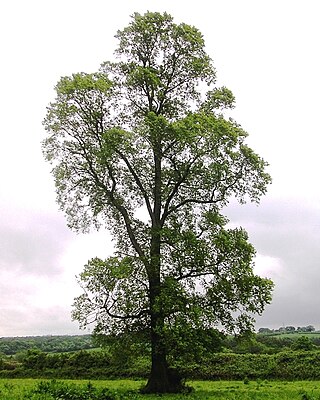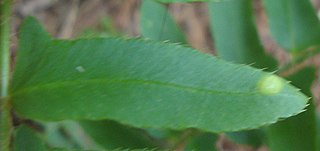
Elms are deciduous and semi-deciduous trees comprising the genus Ulmus in the family Ulmaceae. They are distributed over most of the Northern Hemisphere, inhabiting the temperate and tropical-montane regions of North America and Eurasia, presently ranging southward in the Middle East to Lebanon and Israel, and across the Equator in the Far East into Indonesia.

Taphrina is a fungal genus within the Ascomycota that causes leaf and catkin curl diseases and witch's brooms of certain flowering plants. One of the more commonly observed species causes peach leaf curl. Taphrina typically grow as yeasts during one phase of their life cycles, then infect plant tissues in which typical hyphae are formed, and ultimately they form a naked layer of asci on the deformed, often brightly pigmented surfaces of their hosts. No discrete fruit body is formed outside of the gall-like or blister-like tissues of the hosts. The asci form a layer lacking paraphyses, and they lack croziers. The ascospores frequently bud into multiple yeast cells within the asci. Phylogenetically, Taphrina is a member of a basal group within the Ascomycota, and type genus for the subphylum Taphrinomycotina, the class Taphrinomycetes, and order Taphrinales.

Taphrina deformans is a fungus and plant pathogen, and a causal agent[s] of peach leaf curl. Peach trees infected with T. deformans will experience leaf puckering and distortion, acquiring a characteristic downward and inward curl. Leaves will also undergo chlorosis, turning a pale green or yellow, and later show a red or purple tint. Fruit can either drop prematurely or show surface distortions. Severe infection can also produce lesions on the flowers. The host tree will experience defoliation if the leaves are badly diseased. If a seedling is severely infected, it may die. Almond trees display similar symptoms.

Belcești is a commune in Iași County, Western Moldavia, Romania, situated on the Bahlui River 44 km from Iași. One of the county's largest communes, with a population of 10,555 in 2011, it is composed of six villages: Belcești, Liteni, Munteni, Satu Nou, Tansa, and Ulmi.

Panonychus ulmi, the European red mite, is a species of mite which is a major agricultural pest of fruit trees. It has a high reproductive rate, a short generation time and produces many broods in a year, all of which contribute to its pest status. It has a cosmopolitan distribution, and a very wide host range, having been found on the following plants:

Ulmi is a commune located in Giurgiu County, Muntenia, Romania. It is composed of eight villages: Căscioarele, Drăgăneasca, Ghionea, Icoana, Moșteni, Poenari, Trestieni and Ulmi.

Ulmi is a commune in Dâmbovița County, Muntenia, Romania. It is composed of eight villages: Colanu, Dimoiu, Dumbrava, Matraca, Nisipurile, Udrești, Ulmi and Viișoara.

Milcov is a commune in Olt County, Muntenia, Romania. It is composed of four villages: Milcovu din Deal, Milcovu din Vale, Ulmi and Stejaru. It also included Ipotești village until 2004, when it was split off to form a separate commune.

Taphrina pruni is a fungal plant pathogen of blackthorn that causes the pocket or bladder plum gall, a chemically induced distortion of the fruit (sloes), producing swollen on one side, otherwise deformed and flattened fruit gall without a stone. The twigs on infected plants may also be deformed with small strap-shaped leaves.

Taphrina padi is a fungal plant pathogen that induces the form of pocket plum gall that occurs on bird cherry. The gall is a chemically induced distortion of the fruits, which are swollen, hollow, curved and greatly elongated, without a seed or stone, but retaining the style. The twigs on infected plants may also be deformed with small strap-shaped leaves.
Taphrina bullata is an ascomycete fungus that is a plant pathogen. It causes leaf blisters on pear trees.
Taphrina potentillae is a species of fungus in the family Taphrinaceae. A plant pathogen, it infects the flowers and leaves of species of the genera Potentilla and Parageum. The species was first described under the name Exoascus deformans var. potentillae by American botanist William Farlow in 1883.
Taphrina entomospora is a fungal plant pathogen that infects the leaves of Nothofagus. T. entomospora infection results in chlorosis and changes in parenchyma structure of the leaf causing premature senescence. The species was first described scientifically by mycologist Roland Thaxter in 1910.

Taphrina wiesneri is a plant pathogen causing witch's broom, or plant gall formations, on cherry trees. It is an important pest species of the ornamental cherry Cerasus X yedoensis in Japan.

Taphrina caerulescens is a species of fungus in the family Taphrinaceae. It is a pathogenic Ascomycete fungus that causes oak leaf blister disease on various species of oak trees. The associated anamorph species is Lalaria coccinea, described in 1990. This disease causes lesions and blisters on Oak leaves. Effects of the disease are mostly cosmetic. Although not taxonomically defined, strains of T. caerulescens have been shown to be host specific with varying ¬ascus morphology between strains. There are differences in strains' abilities to metabolize various carbon and nitrogen compounds. This has been proposed as a method of taxonomically defining subspecies within T. caerulescens.

Phytocoris ulmi is a species of plant bugs belonging to the family Miridae, subfamily Mirinae.

Fenusa ulmi, the elm leafminer, is a species of common sawfly in the family Tenthredinidae. It is found in Europe.

Taphrina polystichi is an ascomycete fungus that parasitizes Christmas fern in eastern North America. It was described by A. J. Mix in 1938.

Taphrina tosquinetii is a fungal plant pathogen that causes large blisters on both surfaces of the leaves of alder.

Taphrina betulina is a fungal plant pathogen that causes the gall, witches broom, which is a chemical infection of birch buds or the developing shoots, leading to a proliferation of growth. It was first described by Emil Rostrup in 1883 and is found in Europe, New Zealand and North America.
















